Structure Formation in Antifriction Composites with a Nickel Matrix and Its Effect on Properties
Abstract
:1. Introduction
2. Materials and Methods
3. Results and Discussion
4. Conclusions
- For the first time, a comprehensive study was performed on the manufacturing technology effect on the formation of the EP975 + (4–8)% CaF2 antifriction composite’s an isotropic structure and properties. We have studied the structural features and alloying elements distribution in the new effective composite antifriction material based on powder Ni alloy EP975 with solid lubricant CaF2.
- The developed antifriction composite demonstrates high mechanical and tribological properties and performs well in more severe conditions than known Ni composite material. The mechanical properties of the studied composite are 3.0–3.5 times higher than those of the known Ni powder composite. The composite’s structure substantially effects on the tribological characteristics and determine its behavior in high-temperature friction unit. The developed antifriction composite has a friction coefficient approximately 1.5 times lower than that of the known composite, and wear resistance is more than 7–8 times higher at temperature up to 800 °C. These differences are associated with significant differences in their manufacturing technologies, which lead to differences in their structure’s formation and properties.
- For the first time, it has been shown the elemental homogeneity throughout the composite’s entire volume contributes to the formation of a homogeneous structure, completely excluding segregation. This, in turn, ensures the isotropy of the studied composite’s properties.
- The performed studies demonstrated the correctness of the developed manufacturing technology that was confirmed by the electron microscopy method, micro-X-ray spectral analysis, mechanical and tribological tests. General manufacturing technology, which includes the main operations, such as hot isostatic pressing technology and hardening heat treatment, contributed to the obtaining of a practically isotropic composite with almost the same properties in the longitudinal and transverse directions. The composite is isotropic in its characteristics due to structural homogeneity, without texturing.
- The research results make it possible to recommend the studied antifriction composite for severe operating conditions, such as friction units of turbines, gas pumping stations, and high-temperature antifriction units of foundry metallurgical equipment.
Author Contributions
Funding
Institutional Review Board Statement
Informed Consent Statement
Data Availability Statement
Conflicts of Interest
References
- Kyrychok, P.O.; Roik, T.A.; Gavrish, A.P.; Shevchuk, A.V.; Vitsiuk, Y.Y. New Composite Materials for Friction Parts of Printing Machines. In Monograph; NTUU KPI: Kyiv, Ukraine, 2015; 428p. (In Ukrainian) [Google Scholar]
- Kostornov, A.G. Tribotechnical Materials Science. In Monograph; Publishing House “Knowledge”: Lugansk, Ukraine, 2012; 696p. (In Russian) [Google Scholar]
- Eisen, W.B.; Ferguson, B.L.; German, R.M.; Iacocca, R.; Lee, P.W.; Madan, D.; Moyer, K.; Sanderow, H.; Trudel, Y. Powder Metal Technologies and Applications; U.S. Department of Energy: Washington, DC, USA, 1998.
- Kotkowiak, M.; Adam, P.; Michal, K. The influence of solid lubricant on tribological properties of sintered Ni–20%CaF2 composite material. Ceram. Int. 2019, 45, 17103–17113. [Google Scholar] [CrossRef]
- Szachogluchowicz, I.; Sniezek, L.; Slezak, T.; Kluczyński, J.; Grzelak, K.; Torzewski, J.; Fras, T. Mechanical Properties Analysis of the AA2519-AA1050-Ti6Al4V Explosive Welded Laminate. Materials 2020, 13, 4348. [Google Scholar] [CrossRef] [PubMed]
- Jamroziak, K.; Roik, T.A. Structure and properties of the new antifriction composite materials for high-temperature friction units. In Fracture, Fatigue and Wear; Springer: Singapore, 2018; pp. 628–637. [Google Scholar]
- Jamroziak, K.; Roik, T.A. New antifriction composite materials based on tool steel grinding waste. WIT Trans. Eng. Sci. 2019, 124, 151–159. [Google Scholar]
- Roik, T.A.; Gavrysh, O.A.; Vitsiuk, I. Tribotechnical Properties of Composite Materials Produced from ShKh15SG Steel Grinding Waste. Powder Metall. Met. Ceram. 2019, 58, 439–445. [Google Scholar] [CrossRef]
- Deng, J.; Cao, T.; Yang, X.; Liu, J. Self-lubrication of sintered ceramic tools with CaF2 additions in dry cutting. Int. J. Mach. Tools Manuf. 2006, 46, 957–963. [Google Scholar]
- Roik, T.A.; Rashedi, A.; Khanam, T.; Chaubey, A.; Balaganesan, G.; Ali, S. Structure and Properties of New Antifriction Composites Based on Tool Steel Grinding Waste. Sustainability 2021, 13, 8823. [Google Scholar] [CrossRef]
- Szafranska, A.; Antolak-Dudka, A.; Baranowski, P.; Bogusz, P.; Zasada, D.; Malachowski, J.; Czujko, T. Identification of Mechanical Properties for Titanium Alloy Ti-6Al-4V Produced Using LENS Technology. Materials 2019, 12, 886. [Google Scholar] [CrossRef] [Green Version]
- Hutchings, I.M. Tribological properties of metal matrix composites. Mater. Sci. Technol. 1994, 10, 513–517. [Google Scholar] [CrossRef]
- Zhu, S.; Jun, C.; Zhuhui, Q.; Jun, Y. High temperature solid-lubricating materials. Rev. Tribol. Int. 2019, 133, 206–223. [Google Scholar] [CrossRef]
- Xue, Q.J.; Lu, J.J. The progress of high temperature solid lubricating materials. Tribol. Int. 1999, 19, 91–96. [Google Scholar]
- Migranov, M.S.; Mukhamadeev, V.R.; Migranov, A.M.; Mukhamadeev, I.M.; Khazgalieva, A.A. The improvement of the tribotechnical properties of materials and coatings for metal cutting tool. Mater. Sci. Eng. 2018, 447, 012083. [Google Scholar] [CrossRef]
- Purushotham, G.; Hemanth, J. Action of chills on microstructure, mechanical properties of chilled ASTM A 494 M grade Nickel alloy reinforced with fused SiO2 metal matrix composite. Procedia Mater. Sci. 2014, 5, 426–433. [Google Scholar] [CrossRef] [Green Version]
- Dellacorte, C.; Harold, E.S.; Michael, S.B. Tribological and mechanical comparison of sintered and HIPped PM212: High temperature self-lubricating composites. In Annual Meeting of the Society of Tribologists and Lubrication Engineers; Lewis Research Center: Cleveland, OH, USA, 1992; Volume 48. [Google Scholar]
- Peng, W.; Kun, S.; Meng, Z.; Juan, C.; Junqin, S. Effects of deep cryogenic treatment on the microstructures and tribological properties of iron matrix self-lubricating composites. Metals 2018, 9, 656. [Google Scholar] [CrossRef] [Green Version]
- Kurzawa, A.; Pyka, D.; Pach, J.; Jamroziak, K.; Bocian, M. Numerical modeling of the microstructure of ceramic-metallic materials. Procedia Eng. 2017, 199, 1495–1500. [Google Scholar] [CrossRef]
- Jamroziak, K.; Jargulinski, W.; Piesiak, S. The analysis of hydrogen absorption by the fatigue crack in changeable loaded structure. Adv. Mater. Res. 2014, 1036, 541–546. [Google Scholar] [CrossRef]
- Li, J.L.; Dang, S.X. Tribological properties of nickel-based self-lubricating composite at elevated temperature and counterface material selection. Wear 2008, 265, 533–539. [Google Scholar] [CrossRef]
- Dangsheng, X. Lubrication behavior of Ni–Cr-based alloys containing MoS2 at high temperature. Wear 2001, 251, 1094–1099. [Google Scholar] [CrossRef]
- Bin, C.; Tan, Y.F.; Tu, Y.Q.; Wang, X.L.; Hua, T. Tribological properties of Ni-base alloy composite coating modified by both graphite and TiC particles. Trans. Nonferrous Met. Soc. China 2011, 11, 2426–2432. [Google Scholar]
- Zhu, S.Y.; Bi, Q.L.; Yang, J.; Liu, W.M.; Xue, Q.J. Ni3Al matrix high temperature self-lubricating composites. Tribol. Int. 2011, 44, 445–453. [Google Scholar] [CrossRef]
- Zhu, S.Y.; Li, F.; Ma, J.Q.; Cheng, J.; Yin, B.; Yang, J. Tribological properties of Ni3Al matrix composites with addition of silver and barium salt. Tribol. Int. 2015, 84, 118–123. [Google Scholar] [CrossRef]
- Shi, X.L.; Zhai, W.Z.; Wang, M.; Xu, Z.S.; Yao, J.; Song, S.Y. Tribological behaviors of NiAl based self-lubricating composites containing different solid lubricants at elevated temperatures. Wear 2014, 310, 1–11. [Google Scholar] [CrossRef]
- Shi, X.L.; Xu, Z.S.; Wang, M.; Zhai, W.Z.; Yao, J.; Song, S.Y. Tribological behavior of TiAl matrix self-lubricating composites containing silver from 25 to 800 °C. Wear 2013, 303, 486–494. [Google Scholar] [CrossRef]
- Zhang, X.H.; Cheng, J.; Niu, M.Y.; Tan, H.; Liu, W.M.; Yang, J. Microstructure and high temperature tribological behavior of Fe3Al-Ba0.25Sr0.75SO4 self-lubricating composites. Tribol. Int. 2016, 101, 81–87. [Google Scholar] [CrossRef]
- Kong, L.Q.; Bi, Q.L.; Niu, M.Y.; Zhu, S.Y.; Yang, J.; Liu, W.M. High-temperature tribological behavior of ZrO2-MoS2-CaF2 self-lubricating composites. J. Eur. Ceram. Soc. 2013, 33, 51–59. [Google Scholar] [CrossRef]
- Zhen, J.M.; Li, F.; Zhu, S.Y.; Ma, J.Q.; Qiao, Z.H.; Liu, W.M. Friction and wear behavior of nickel-alloy-based high temperature self-lubricating composites against Si3N4 and Inconel 718. Tribol. Int. 2014, 75, 1–9. [Google Scholar] [CrossRef]
- Li, F.; Cheng, J.; Qiao, Z.H.; Ma, J.Q.; Zhu, S.Y.; Fu, L.C. A nickel-alloy-based high-temperature self-Lubricating composite with simultaneously superior lubricity and high strength. Tribol. Lett. 2013, 49, 573–577. [Google Scholar] [CrossRef]
- Zhen, J.M.; Zhu, S.Y.; Cheng, J.; Qiao, Z.H.; Liu, W.M.; Yang, J. Effects of sliding speed and testing temperature on the tribological behavior of a nickel-alloy based solid-lubricating composite. Wear 2016, 45, 368–369. [Google Scholar] [CrossRef]
- Li, Y.F.; Yin, H.; Li, X.L.; Mao, C.C. Friction and wear properties of spark plasma sintering NiCr-SrSO4 composites at elevated temperatures in sliding against alumina ball. Tribol. Lett. 2016, 64, 29–38. [Google Scholar] [CrossRef]
- Wang, J.Y.; Shan, Y.; Guo, H.J.; Li, B.; Wang, W.Z.; Jia, J.H. Friction and wear characteristics of hot-pressed NiCr-Mo/MoO3/Ag self-lubrication composites at elevated temperatures up to 900 °C. Tribol. Lett. 2015, 59, 48–63. [Google Scholar] [CrossRef]
- Luo, J.; Liu, X.B.; Xiang, Z.F.; Shi, S.H.; Chen, Y.; Shi, G.L. Synthesis of high-temperature self-lubricating wear resistant composite coating on Ti6Al4V alloy by laser deposition. J. Mater. Eng. Perform. 2015, 24, 1881–1889. [Google Scholar] [CrossRef]
- Chelariu, R.; Bolat, G.; Izquierdo, J.; Mareci, D.; Gordin, D.M.; Gloriant, T.; Souto, R.M. Metastable beta Ti-Nb-Mo alloys with improved corrosion resistance in saline solution. Electrochim. Acta 2014, 137, 280–289. [Google Scholar] [CrossRef]
- Nagase, T.; Todai, M.; Hori, T.; Nakano, T. Microstructure of equiatomic and non-equiatomic Ti-Nb-Ta-Zr-Mo high-entropy alloys for metallic biomaterials. J. Alloy. Compd. 2018, 753, 412–421. [Google Scholar] [CrossRef]
- Saunders, N.; Miodownik, A.P. CALPHAD, Calculation of Phase Diagrams: A Comprehensive Guide, 1st ed.; Elsevier: Amsterdam, The Netherlands, 1998; 479p, Available online: http://moemesto.ru/portonik6/file/3717877/CALPHAD_Calculation-of-Phase-Diagrams.pdf (accessed on 18 April 2022).
- Turchi, P.E.A.; Kaufman, L.; Liu, Z.-K. Modeling of Ni-Cr-Mo Based Alloys: Part I-Phase Stability. Calphad 2006, 30, 70–87. [Google Scholar] [CrossRef]
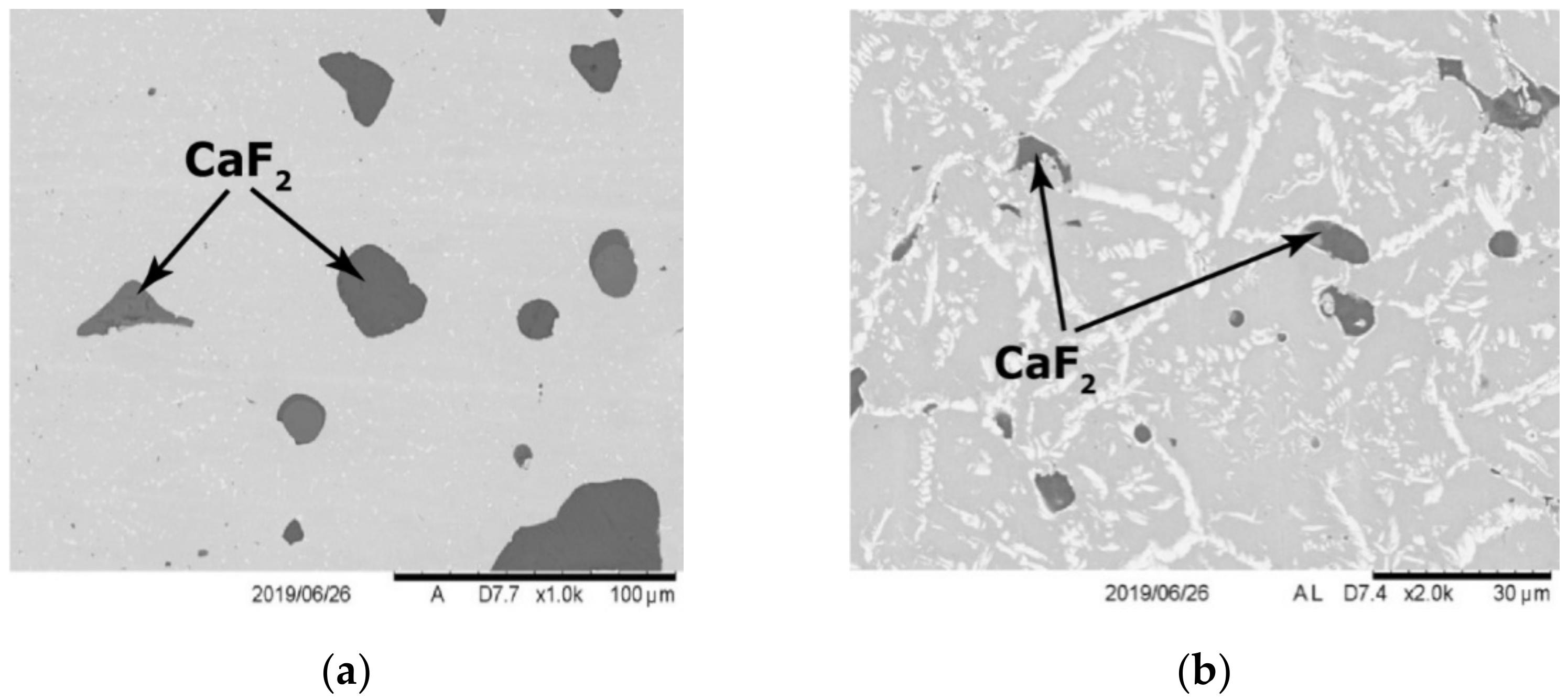
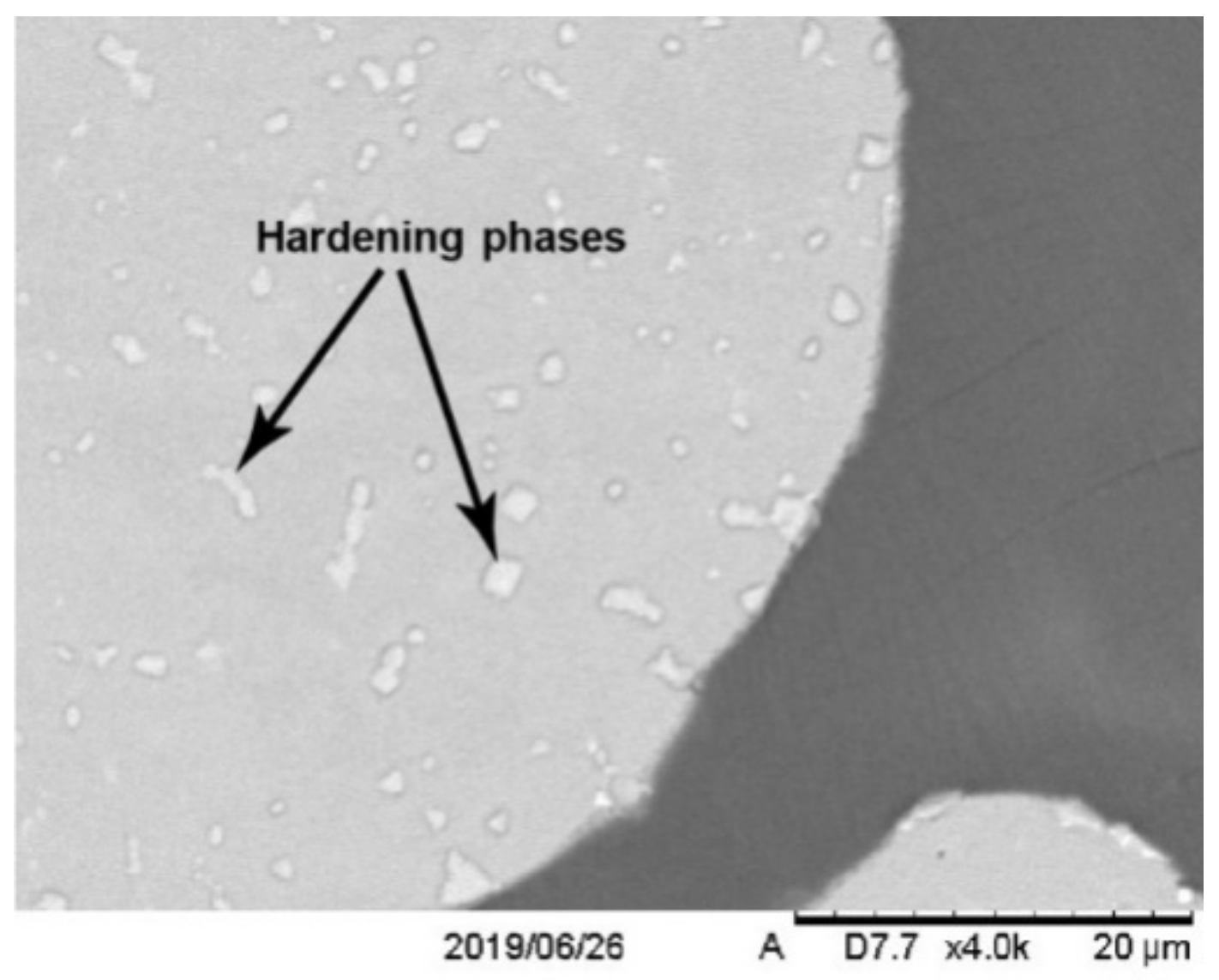
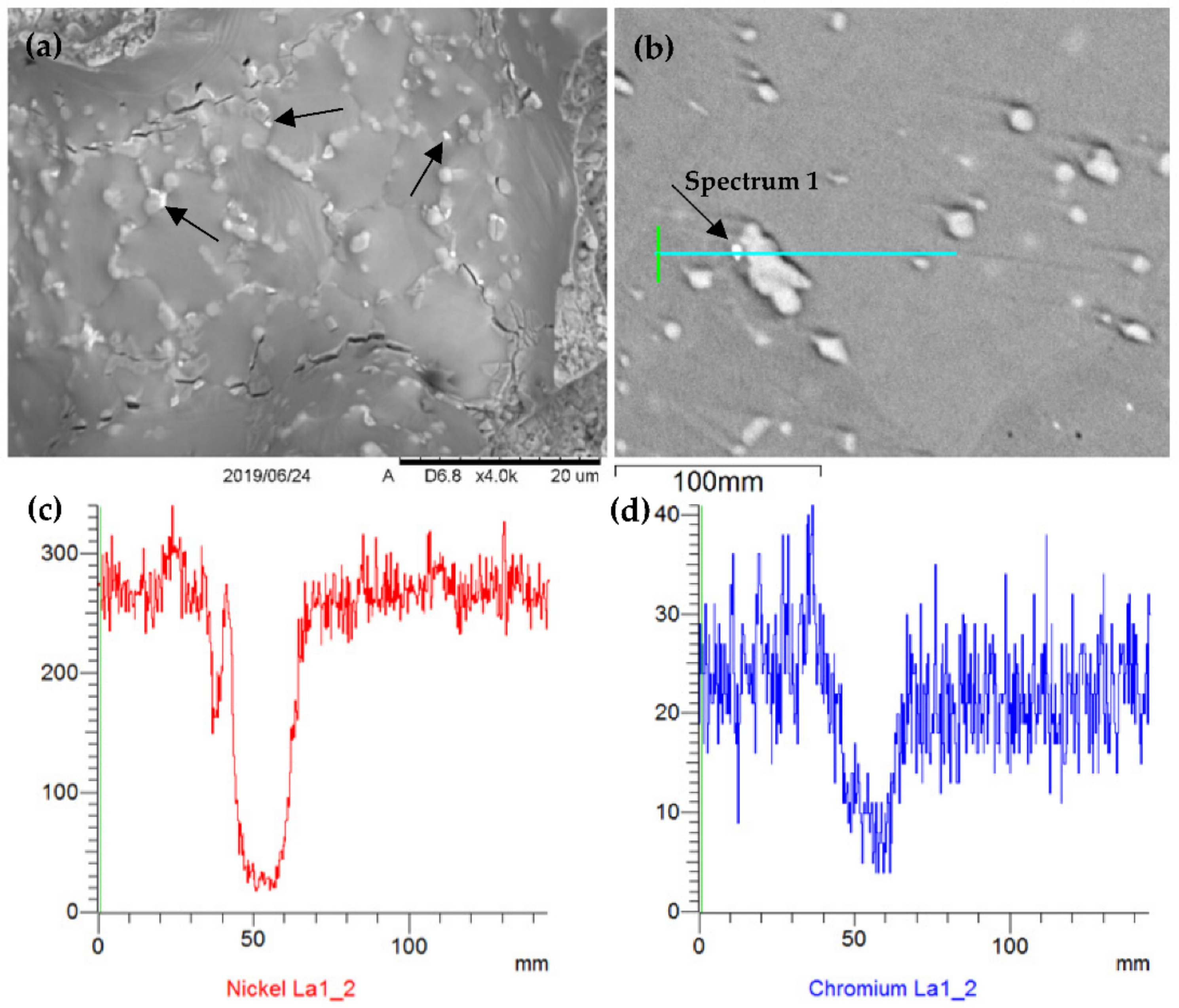
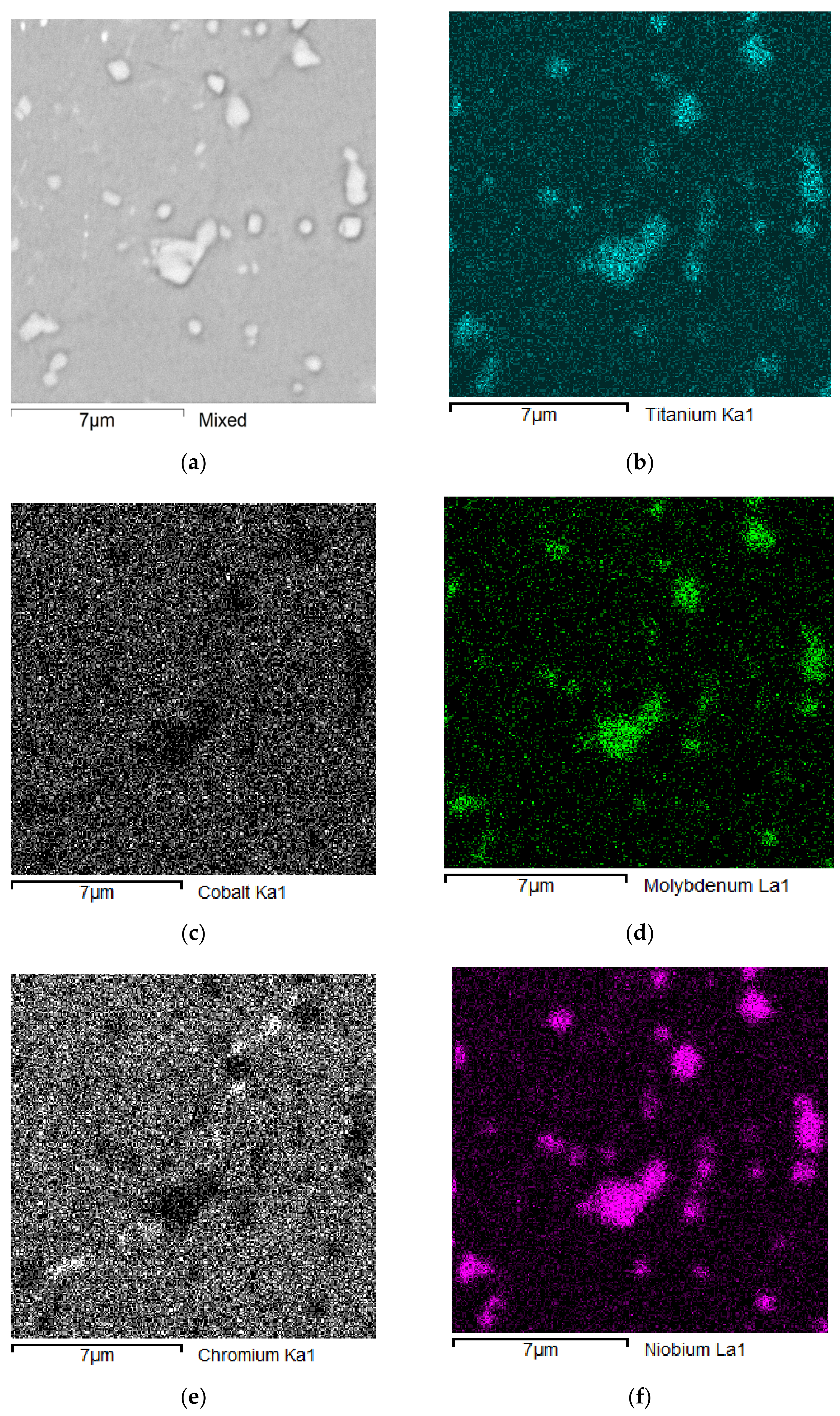
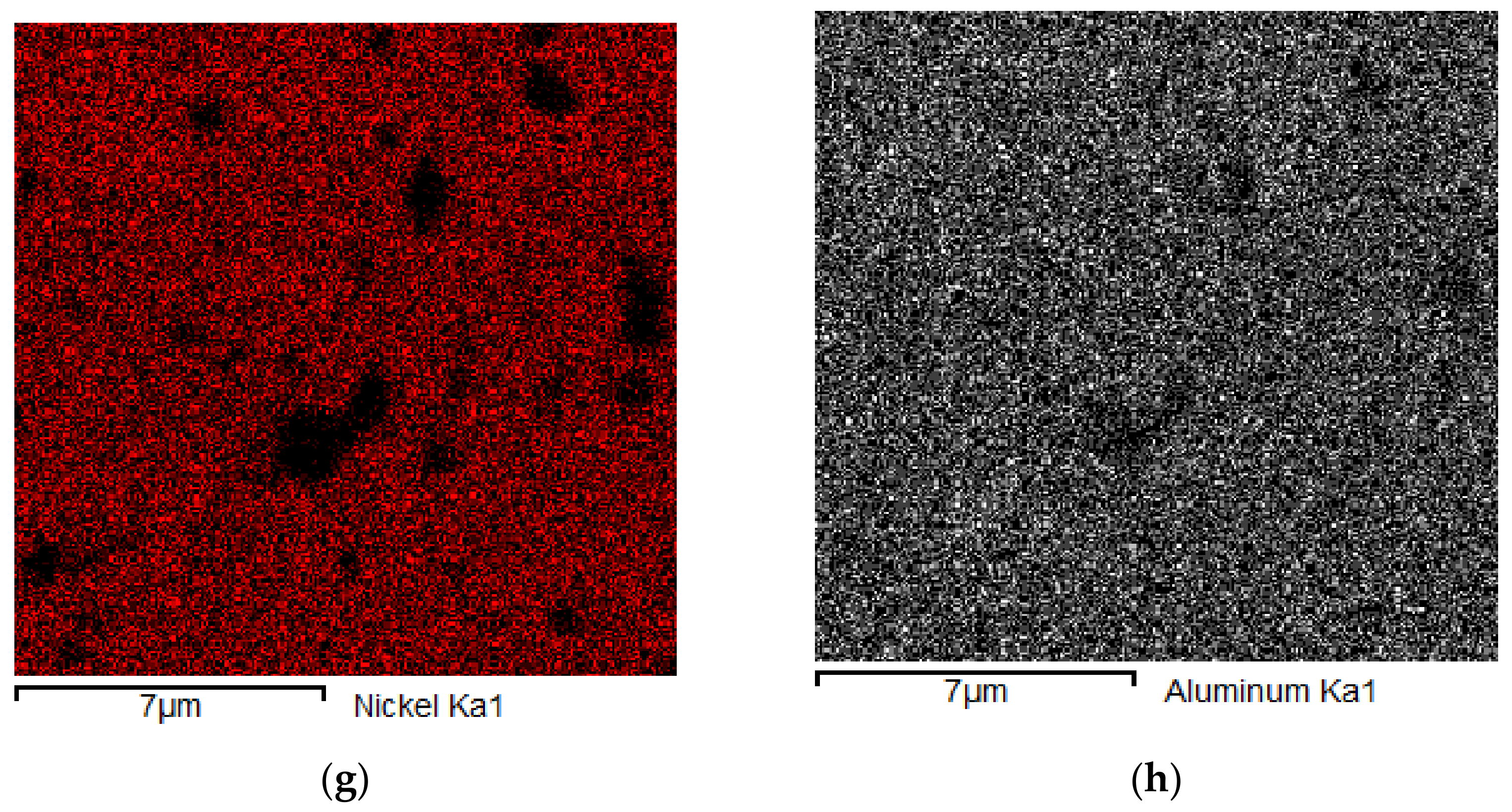

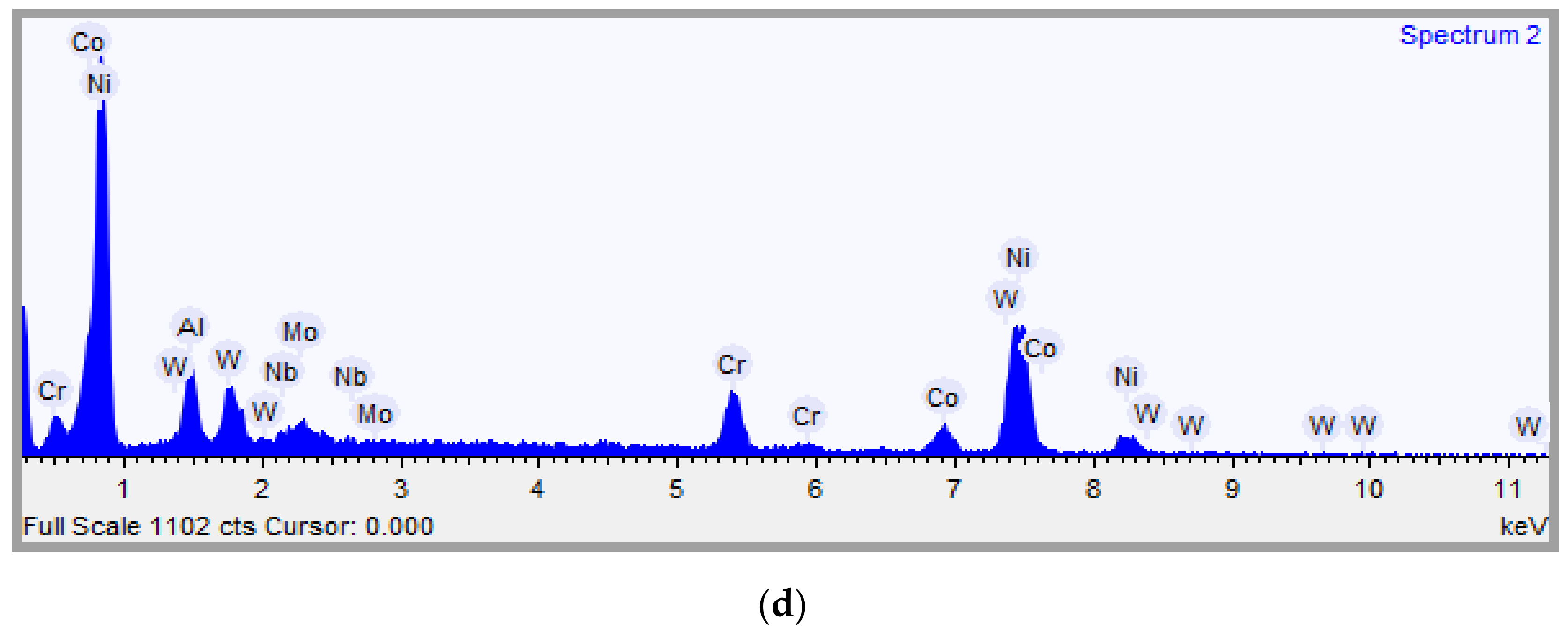
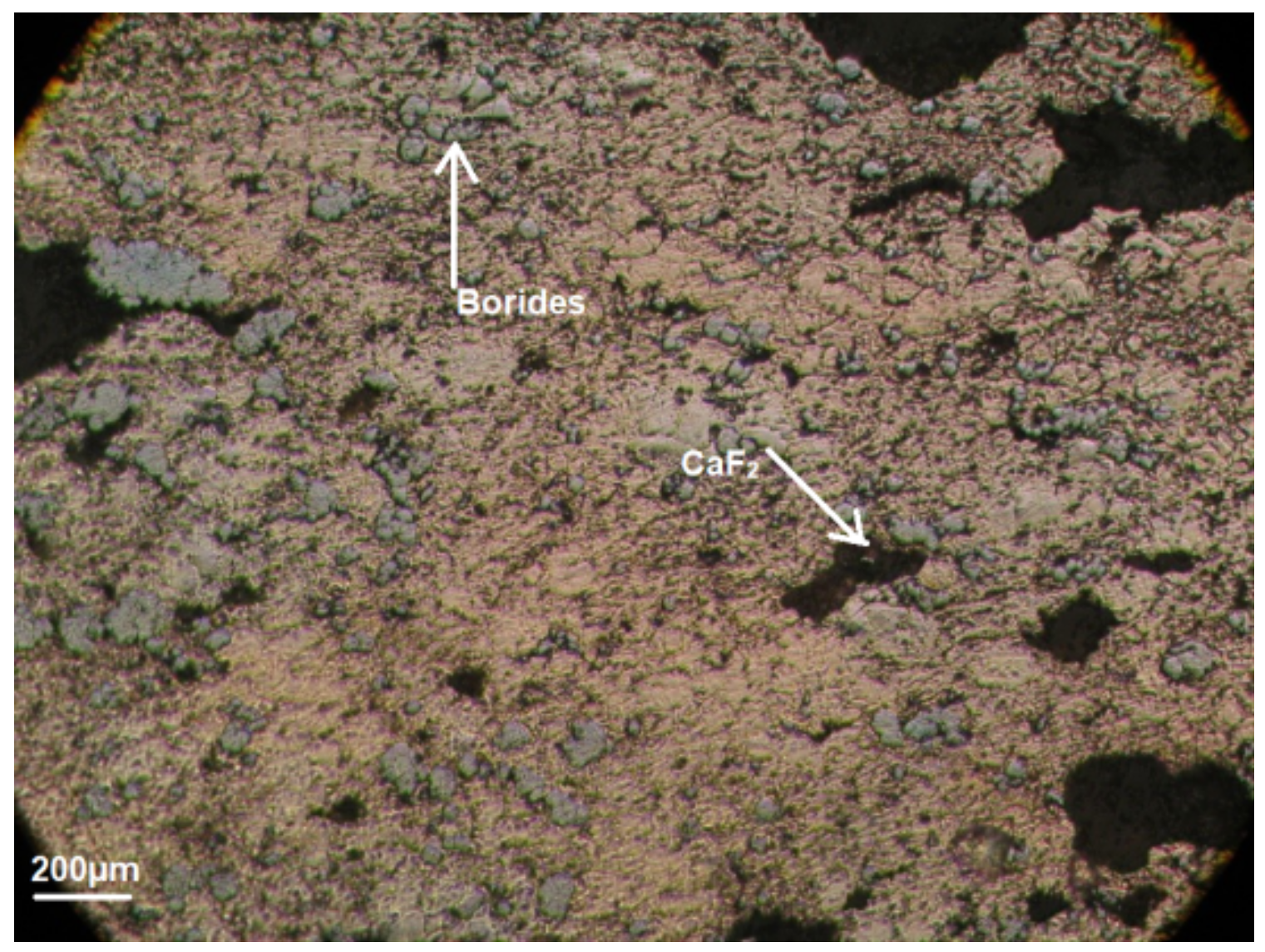
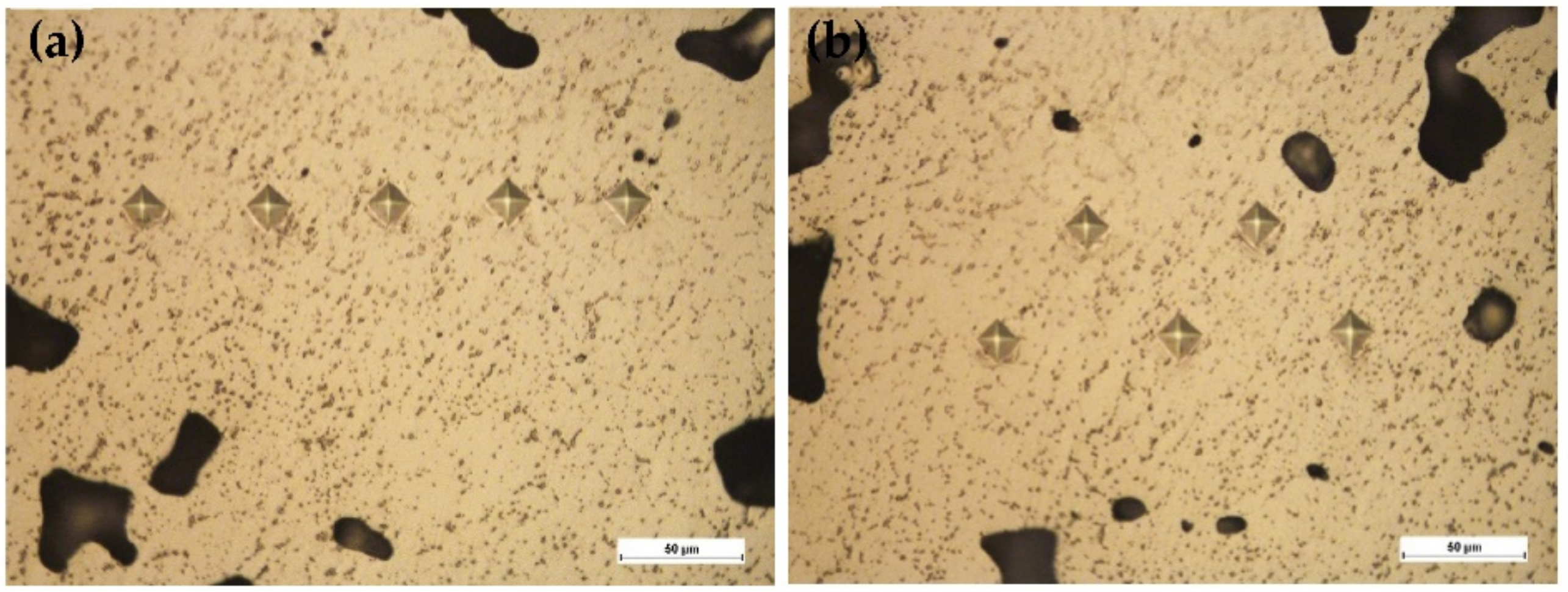
| Components, wt.% | ||||||||||
|---|---|---|---|---|---|---|---|---|---|---|
| Carbon | Tungsten | Chromium | Molybdenum | Vanadium | Silicon | Nickel | Manganese | Sulfur | Phosphorus | Iron |
| 0.10–0.16 | 1.60–2.00 | 10.5–12.0 | 0.35–0.50 | 0.18–0.30 | to 0.6 | 1.50–1.80 | to 0.6 | to 0.025 | to 0.030 | basis |
| Components, wt.% | |||||||||
|---|---|---|---|---|---|---|---|---|---|
| Carbon | Tungsten | Chromium | Molybdenum | Titanium | Aluminium | Niobium | Cobalt | Nickel | Calcium Fluoride |
| 0.038–0.076 | 8.65–9.31 | 7.6–9.5 | 2.28–3.04 | 1.71–2.09 | 4.75–5.13 | 1.71–2.59 | 9.5–11.4 | basis | 4.0–8.0 |
| Element | Cr | Ni |
|---|---|---|
| Weight % | 33.382 | 66.618 |
| Atomic % | 36.135 | 63.865 |
| Element | Ti | Nb | Mo |
|---|---|---|---|
| Weight % | 27.215 | 65.126 | 7.658 |
| Atomic % | 42.118 | 51.965 | 5.917 |
| Element | C | O | Al | Ti | Cr | Mo | Co | Nb | W | Ni |
|---|---|---|---|---|---|---|---|---|---|---|
| Weight % | 0.048 | 0.118 | 4.361 | 1.416 | 9.974 | 3.535 | 9.083 | 5.084 | 9.770 | 56.611 |
| Atomic % | 0.145 | 0.372 | 7.460 | 1.364 | 8.966 | 4.442 | 8.330 | 4.532 | 8.261 | 56.128 |
| Composition, wt. % | Porosity, % | Tensile Strength, σt, MPa | Charpy Impact Strength, KC, J/m2 | Hardness HB, MPa | Friction Coefficient/ Wear Rate, µm/km (at 5 MPa and 800 °C) | Maximum Allowable Load, MPa/ Temperature, °C |
|---|---|---|---|---|---|---|
| EP975 + (4–8) CaF2 | 0.1–0.11 | 1010–1170 | 520–650 | 2530–2610 | (0.23–0.25)/(41–45) | 5/800 |
| Ni + (18–45) (MoB2 + ZrB2) + 5 (CaF2 or BaF2) composite material [1,2,6] | 13–15 | 240–310 | 350–520 | 850–950 | 0.34/368 | 1.5/550 |
| Composition, wt. % | Relative Elongation, δ, %, Test Direction | Relative Narrowing, ψ, %, Test Direction | Tensile Strength, σt, MPa Test Direction | Hardness, HB, MPa, Test Direction | ||||
|---|---|---|---|---|---|---|---|---|
| Longitudinal | Transverse | Longitudinal | Transverse | Longitudinal | Transverse | Longitudinal | Transverse | |
| EP975 + (4–8) CaF2 | 9.6–10.3 | 9.8–10.2 | 11.9–12.6 | 11.6–12.4 | 1010–1170 | 1005–1165 | 2550–2600 | 2530–2590 |
| Ni + (18–45) (MoB2 + ZrB2) + 5 (CaF2 or BaF2) composite material [1,2,6] | 4.1–4.3 | 2.7–2.9 | 5.7–6.0 | 4.4–4.7 | 240–310 | 170–190 | 850–950 | 780–790 |
| Area | Microhardness HV0.1 | |||||
|---|---|---|---|---|---|---|
| Test 1 | Test 2 | Test 3 | Test 4 | Test 5 | Average | |
| Area 1 | 510 | 516 | 497 | 504 | 510 | 507 |
| Area 2 | 495 | 510 | 501 | 497 | 512 | 503 |
| Area 3 | 510 | 514 | 479 | 520 | 506 | 506 |
| Area 4 | 516 | 493 | 519 | 504 | 501 | 507 |
| Area 5 | 446 | 512 | 499 | 516 | 504 | 495 |
Publisher’s Note: MDPI stays neutral with regard to jurisdictional claims in published maps and institutional affiliations. |
© 2022 by the authors. Licensee MDPI, Basel, Switzerland. This article is an open access article distributed under the terms and conditions of the Creative Commons Attribution (CC BY) license (https://creativecommons.org/licenses/by/4.0/).
Share and Cite
Olaleye, K.; Roik, T.; Kurzawa, A.; Gavrysh, O.; Vitsiuk, I.; Jamroziak, K. Structure Formation in Antifriction Composites with a Nickel Matrix and Its Effect on Properties. Materials 2022, 15, 3404. https://doi.org/10.3390/ma15093404
Olaleye K, Roik T, Kurzawa A, Gavrysh O, Vitsiuk I, Jamroziak K. Structure Formation in Antifriction Composites with a Nickel Matrix and Its Effect on Properties. Materials. 2022; 15(9):3404. https://doi.org/10.3390/ma15093404
Chicago/Turabian StyleOlaleye, Kayode, Tetiana Roik, Adam Kurzawa, Oleg Gavrysh, Iulia Vitsiuk, and Krzysztof Jamroziak. 2022. "Structure Formation in Antifriction Composites with a Nickel Matrix and Its Effect on Properties" Materials 15, no. 9: 3404. https://doi.org/10.3390/ma15093404






